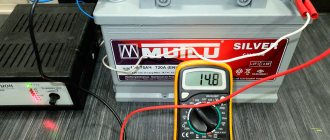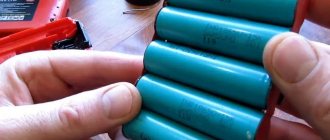The need to recharge a car battery arises quite often. This is due to urban operating conditions when short trips are made by car.
Although in theory the generator should compensate for the lost capacity of the battery, in real conditions this cannot be achieved. Therefore, there is a need to use chargers.
Not everyone has their own garage. Because of this, the car is usually located in the yard, under the apartment windows, or in the parking lot. If there is a need to charge the battery, it is unlikely that it will be possible to do it right on the street, since the charger requires a connection to a 220 V network. And then the logical idea arises to take the battery into a house or apartment, where it can be charged.
But not everyone knows whether it is possible to charge car batteries at home and what the potential dangers of such a decision are.
Why is it dangerous to charge a battery in a residential area?
You should study in more detail the question of whether it is actually possible to charge a car battery in an apartment or in a private house. There is no fundamental difference here, since we are talking about premises inside the building.
Modern starter batteries are a type of lead-acid battery. That is, they are based on a set of lead plates with different coatings, as well as a liquid medium consisting of sulfuric acid and distilled water.
This raises a natural interest: is it really possible to charge a battery in the living room of a house? It doesn’t really matter whether it’s a house or an apartment. In both cases, we mean a room in which people are located. It is logical to ask whether a potentially harmful battery will actually be dangerous to human health or life. Or, if you charge the battery, nothing bad will happen, these are banal inventions.
There are several main reasons why you cannot actually charge a car battery in a house or apartment:
- hydrogen combustion;
- release of harmful gases;
- acid.
Now about each point separately. This will make it clear how harmful and dangerous it actually is to charge a battery at home.
Hydrogen
There are many examples and stories of batteries exploding while charging.
The most prone to explosions are classic serviced lead-acid batteries, where the electrolyte is presented in the form of a transparent liquid.
The electrolyte consists of sulfuric acid and distilled water, which are mixed with each other in proportions of about 1 to 3. Until the battery is fully charged, nothing will happen to the working fluid. But if the charge continues to flow, although the battery has already been charged, the boiling process will begin.
The electrolyte does not boil due to heating to 100 degrees Celsius. Boiling is only a conditional name, since in fact electrolysis occurs due to the effect of current on the liquid. This provokes the breakdown of water into hydrogen and oxygen, which entails the release of bubbles.
Outwardly, this resembles boiling water, although in reality boiling of the electrolyte is possible already at 40–45 degrees Celsius.
If we talk about whether it is possible to charge a battery at home, it is important to understand that the gas released from the battery is extremely explosive.
How to properly charge the battery
Depending on the condition of the battery, it requires some attention. The battery must be recharged in time when the generator cannot cope with the load or when there is a strong loss of charging current. Not to mention the self-discharge current, which inevitably drains the battery. even when idle.
In these cases, additional recharging is necessary. If you do not charge in time, this can lead to complete failure of the battery, shedding of the plates and short circuit of the cans. After this, in most cases, restoration of performance is no longer possible. This is especially true during winter operation.
How to choose a charging location
Charging a battery at home is potentially dangerous. Yes, if you follow all the rules and are extremely careful, you won’t have to worry about any explosions or burns.
But it's best to be safe. For this:
- Place an acid-resistant material under the battery being charged at home so as not to spoil the floor covering;
- carefully study the instruction manual and determine the optimal conditions for charging the battery, applying the appropriate voltage, charge current, etc.;
- give preference to modern automatic chargers that will automatically stop supplying charge when the process is complete;
- to avoid rupture of the case, before starting charging, unscrew the plugs slightly, but not completely, on all banks of the battery being serviced;
- It is better to use a relatively safe place, such as a balcony or loggia, as a charging room;
- Before charging, ensure a constant flow of fresh air and its circulation.
After placing the battery on the balcony or loggia, open the windows. The motorist himself, as well as his family members, are recommended to minimize their presence in the room where the battery is being charged. But we must not forget to periodically approach to monitor the process and turn off the charger in a timely manner.
But it’s better not to use living rooms for tasks such as battery charging. This is done as a last resort. And only on condition that the room is well ventilated (windows are open or the hood is running) and no one is inside.
What types of batteries can be charged at home?
It turns out that, from a safety point of view, charging the battery at home is not recommended. But what if there are no other options? Does this apply to all types of batteries? Maybe it’s still possible to somehow safely charge a car battery at home, without causing any inconvenience to the inhabitants of the house?
Experts note that two new technologies have emerged that are absolutely safe and environmentally friendly in all respects and are optimally suited for indoor charging. Of course, we are talking about AGM and gel batteries. Due to their design features:
- An AGM battery does not have a liquid medium in its usual form - the electrolyte is securely locked in special absorbent containers;
- In gel batteries, the electrolyte is turned into a jelly-like substance; there is absolutely nothing to boil or evaporate there.
These modern types of batteries should be charged in strict accordance with the instructions, using a special charger recommended by the manufacturer.
In addition, car owners often have a question: is it possible to charge a cold battery at home? The answer is clear: no, neither at home nor in any other place a cold battery, that is, a battery just brought in from the cold cannot be charged. This is absolutely useless, in this state its conductivity will be equal to zero, which means that it simply will not be capable of receiving a charge. Please note that before charging, the battery temperature must be brought to room temperature.
How to properly charge your battery at home
It all starts with buying a charger. Its characteristics depend on the vehicle network voltage (6 V for mopeds and motorcycles, 12 V for cars, 24 V for trucks), and battery capacity. The device must provide a current 10 times less than the rated capacity of the AKD. For example, if the current source is rated at 150 Ampere/hour, then the charger should produce a current of 15 Amperes. There are devices for standard and accelerated charging.
When the device is purchased, you can proceed to the procedure itself:
- Remove the battery from the car and bring it home. After disconnecting the terminals, all settings of the machine’s equipment will be lost: radio, air conditioning, clock, etc. If the temperature outside is sub-zero, let it sit at least overnight in a warm place. There is no need to warm it with hot water or a blowtorch. This will end in fire.
- Connect the charging terminals to the battery. Plus for plus, minus for minus.
- Plug in the charger and select the desired mode. If the charger has several of them, then to service lead batteries you need to set the WET mode, for dry ones - AMG, GEL - for gel ones. The electrolyte type is indicated on the battery case.
- Now adjust the current: 10% capacity WET, up to 25% AMG, GEL.
- Calculate the time it will take to fully recharge: it depends on whether the charge is completely used up or not.
Calculation example: the nameplate capacity of the battery is 150 A/h, 50% of the charge has been spent, it is necessary to restore it with a current of 7.5 Amps for at least 10 hours (maximum 30 hours). This is for WET type. The same calculation for AMG, GEL: initial capacity 150 A/h, restore 75 A/h (half) with a current of 15 Amps for 5 - 15 hours.
Even if there is a fast charging mode, it is better to use the normal procedure. This is a more gentle option for plates. To properly charge the battery at home and calculate the required current, use the table:
| Battery capacity (Ah) | Lead | Gel | AGM | |||
| Charging method _ | ||||||
| Regular | Fast | Regular | Fast | Regular | Fast | |
| 20 | 2A | 6-14A | 5A | 10-14A | 5A | 10-14A |
| 60 | 6A | 18-55A | 15A | 30-55A | 15A | 30-55A |
| 100 | 10A | 30-70A | 25A | 50-70A | 25A | 50-70A |
| 150 | 15A | 45-100A | 35A | 75-100A | 35A | 75-100A |
| 200 | 20A | 60-140A | 50A | 100-140A | 50A | 100-140A |
Chargers of the latest modifications have a light indication: charging is in progress, work is completed, a failure has occurred. Keep an eye out from time to time.
Operating principle of the circuit
Until the voltage at the terminals of the battery being charged reaches 16.5, at pin 2 of A1 it is enough to open transistor VT1, which is responsible for triggering relay P1, which turns on contacts K1.1, which connect the primary winding of the transformer through a capacitor block.
From this moment charging begins. As soon as the value becomes 16.5 V, the voltage at output A1.1 decreases and does not allow keeping VT1 open. Because of this, the relay will turn off, and contacts K1.1 through capacitor C4 (charge current 0.5A) connect a transformer. The charger circuit is in this state until the battery voltage drops to 12.54V. Then the relay will turn on again and charging will begin. Thanks to switch S2, it is possible to disable auto-regulation (if necessary). This will eliminate the possibility of overcharging the battery, even if it remains connected to the charger for a long time. This mode is very relevant for those who drive a car exclusively in warm weather. At the end of the season, the battery is charged and turned off with the onset of spring. Even if the voltage disappears, after it appears, charging will continue.
At lower voltage, i.e. If this value has not been reached, the voltage at output 8 A1.2 is sufficient for transistor VT2 to be open, and it is supplied to the relay.
If it is more than 19V, the transistor closes, the relay opens contacts K2.1, stopping the supply of voltage to the charger. When a battery is connected to power the circuit, the charger returns to working condition.
Where is the best place to charge?
You should not charge when the battery is already dying. In this case, it is too late to take action. Constant recharging on a competent charger will extend the life of the battery and ensure normal engine starting even in the cold. But here the question arises, which place to choose for this event. A heated garage with decent conditions for servicing a car is a luxury, but in the cold, naturally, no one does this, because for high-quality charging it is necessary to create certain conditions:
- You can charge either in the car or charge with the battery removed;
- the room must meet a number of requirements: good ventilation, positive temperature, low humidity;
- the process is carried out only if there are no flammable objects nearby;
- The battery must be cleaned of dust, the terminals must be treated and the oxide must be removed from them;
- charging must be carried out with a high-quality charger capable of monitoring the charging current and voltage and, if necessary, changing their values.
In this regard, a dilemma may arise as to whether it can be charged at home, in residential areas.
How to determine which charger circuit is suitable for a car battery
If a gel battery is used, it can be charged from a charger with a circuit that is a classic voltage stabilizer, at the output of which there is a programmable current limiter, current separating resistances R2-R6, an L200C microcircuit, a resistor (from 14 to 15) that adjusts the output voltage.
The transformer is selected so that a voltage of 15 volts is obtained at the output of the secondary winding. When using diodes placed in a metal case, they can be installed not only on the radiator.
The charger circuit for a car battery consists of several separate circuits and is not complicated, so it is not difficult to assemble it yourself.
Lead-acid batteries are critical to operating conditions. This condition is considered to be charge-discharge. When recharging, their electrolyte boils away, which threatens to destroy the positive plates.
When you need charging away from the garage, but there is no device, you can “make it” using improvised means. For this you will need: a powerful 10A diode installed on the radiator, and an incandescent lamp rated for 220V.
The next scheme is somewhat more complicated. It uses a boiler or an electric stove as a load.
A diode bridge from an old computer's power supply is suitable for it. On the contrary, it is better not to use Schottky diodes due to the high reverse voltage - 50-60 V, which is why they burn out instantly.
In the automatic charger circuit, a 9 V microcircuit of type 142EN8G (DA 1) is used to power the operational amplifier. For every 10 degrees change in the temperature of its body, the output voltage responds by increasing by hundredths of a volt.
For an automatic shutdown system, it is enough to assemble the circuit on half of the microcircuit with a voltage reading of 15.6V. The terminals of the fourth microcircuit are connected to two voltage dividers - R7, R8 (4.5 V comes from it) and R4-R6. R5 - a trimming resistor is needed to determine the automatic response threshold of 12.54 V. The required hysteresis between the voltage that turns on battery charging and its completion is provided by R9 and VD7
Explosion hazard of the device
There are quite a few videos online showing how a car battery explodes. If you are interested, you can figure out the reason for what is happening. The reasons for the explosion can be different:
- The battery is being serviced, its banks are open, and the gas rises up.
- If the battery has been charging for a long time and is already boiling, and a lot of gas has accumulated inside.
- If a spark hits the gas, it will immediately ignite and an explosion will follow. This can also happen if there is an open fire or hot objects near the battery, for example, an electric stove with a spiral.
It is very dangerous. Charging should be done wisely. If the car battery explodes, there may be a fire. Acid may also leak from the battery and burn your skin.











